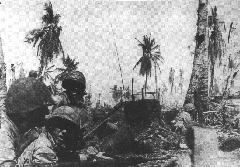|
A Website Created by Tim Lanzendörfer
"Those who forget the past are condemned to relive it"
|
|

Contributors Wanted! |
|
Recent Updates:
11/10/2003: Uploaded a new Battle to the Battles Section. 20/03/2003: Uploaded a new Personal account to the Personal Section. 01/10/2002: Uploaded a new aircraft description to the Aviation Section. |
Visitor Participation:
For Comments: Sign the Guestbook |
For all cosmetical etc. changes see the Updates. For the change in philosophy, read on.
This site is no longer "The U.S. Navy in the Pacific War 1941 -- 1945", but it is "The Pacific War: The U.S. Navy". "Uh," you say, "where's the difference"?
I don't know yet...but for what it's worth, it allows me to include it in a larger set of pages that might include the Marines and Army, or might include larger pages on the Allies. "Might??", you say? "Didn't you have a couple of Allied links already? I dimly remember so!" Yep, but they're gone. I took them off because they were not filled with any substantial content. And on the rest of the prospects: well...I'm still young, and I presume time will tell what will become of this idea. Oh, and you can always step in and say "do a site on the Marines? Hoooorahhhh!", which would mean "Yes, I shall be pleased to take that task upon me.".
Anyway. Those few of you who may not have had the dubious pleasure of having been here before, may want to
receive a short introduction. Alright.
This site tries to deal with "the other side" -- to be a complement to Jon Parshall's tremendous, huge, brilliant,
amazing, lovely, adjective-draining IJN site, so to speak -- and to enlight you to the U.S. Navy's contribution
to the overall victory that ended World War II. So this is one of those occasions were for most people "the other side"
happens to be "their own side".
That ought to be it for introduction...but you can receive some tips on this site by visiting
Tips for Viewing. Anything else, the below is pretty
self-explanatory.
|





|
![]()
Submit your site to 34 popular sites for free, using one form!